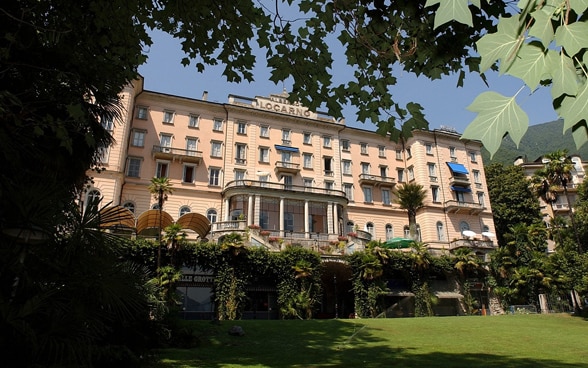The Locarno Treaties: stabilising peace in Europe in the aftermath of the First World War
In 1925, Locarno found itself at the centre of international events. Between 5 and 16 October, the town hosted the negotiations for the Locarno Pact, a series of seven international treaties aimed at stabilising peace in Europe following the First World War. Switzerland's role as neutral host country was pivotal. Through its good offices, it offered the ideal location for a rapprochement between former wartime enemies.

Delegations from Germany, France, Belgium, the United Kingdom, Italy, Poland and Czechoslovakia came to Locarno to negotiate in October 1925. © World Digital Library
After the First World War, Europe was a shattered continent. Germany surrendered in 1918 after four years of war. In 1919, the Treaty of Versailles formally ended the war, but Germany's relations with its neighbours, particularly France and Belgium to the west, were marred by deep resentment, reparation claims and territorial losses. These tensions threatened to spark fresh conflicts. More work was needed to reintegrate Germany into the wider European framework under the terms of the Treaty of Versailles.
Against this backdrop, Locarno was consciously chosen as the location of a conference by the organisers Germany, France and the UK. The Italian-speaking town in southern Switzerland had not been the scene of battles, nor was it part of an imperial power base – it was neutral, charming and a popular tourist resort. Diplomat Miles Lampson, member of the British delegation at the time, described Locarno as "perfectly beautiful… a nice little town, rather Italian than Swiss in character, nestling under high mountains on the shores of the Lake." It was a place where reconciliation seemed possible.
Diplomatic breakthrough
Seven countries took part in the negotiations: Germany, France, Belgium, the UK, Italy, Poland, and Czechoslovakia. The negotiations on seven different agreements were designed to advance a pragmatic and solution-focused diplomacy – underpinned by a desire to restore confidence, promote stability, and ultimately to guarantee peace.
At the centre of the negotiations was the Rhineland Pact in which Germany accepted its western borders with France and Belgium – including renouncing claims to Alsace-Lorraine – and undertook to resolve differences peacefully. The UK and Italy acted as guarantors of the Rhineland Pact. A number of arbitration treaties were also signed between Germany and its neighbours, under which any future disputes were to be resolved through institutionalised, third-party mechanisms. The signal was clear: Europe was no longer to be about confrontation, but about cooperation. The participants agreed to renounce the use of force – except in self-defence – and committed to multilateralism.
A pledge for peace in Europe
The Locarno Treaties were officially signed on 1 December 1925 in London, but the actual diplomatic breakthrough happened in Locarno – in the meeting rooms of the Palazzo del Pretorio and at unofficial meetings in the Grand Hotel Locarno. This is where the delegations debated, argued and finally reached an agreement. The seven individual Locarno treaties were signed on 16 October 1925 at the Palazzo del Pretorio in Locarno by the representatives of Germany (Gustav Stresemann), Belgium (Emile Vandervelde), France (Aristide Briand), the UK (Austen Chamberlain), Italy (Vittorio Scialoja, Benito Mussolini), Poland (Aleksander Skrzyński) and Czechoslovakia (Edvard Beneš).

British historian A.J.P. Taylor later remarked (referring to the Locarno Pact): "Its signature ended the First World War; its repudiation eleven years later marked the prelude to the Second." The Locarno Treaties did indeed usher in a more peaceful decade, but one which came to a bitter end in 1936 when Germany's National Socialist government remilitarised the Rhineland. Despite its failure, the Locarno Pact remains a glimmer of hope. Signatories Gustav Stresemann, Aristide Briand and Austen Chamberlain were honoured with the Nobel Peace Prize in 1926 – in recognition of policy based on dialogue.

A host state for peacebuilding
The fact that Locarno was the stage for this rapprochement is inextricably linked to Switzerland's neutral role. As a country without imperial ambitions, it was the perfect candidate to get international players around the table. The choice of Locarno therefore also reflected confidence in Switzerland's role and its foreign policy – a policy geared to mediation, dialogue and stability.
This tradition continues today, with Switzerland offering its good offices in numerous international mediation processes, from Latin America to Africa and Asia. The events of 1925 are an early example of how host state policy and impartiality can make real peaceful solutions possible.
Good offices: more relevant than ever
The Locarno Treaties were more than a diplomatic agreement – they were a declaration of common understanding. Although the Pact was not ultimately able to guarantee lasting peace, it sent out a strong signal: that hostility can be overcome by building trust.
Switzerland used its role as host state to create space for understanding. In a time of growing geopolitical tensions, the importance of a bridge-building, neutral foreign policy is more relevant than ever and remains a central pillar of Switzerland's peacebuilding activities worldwide.
100 years of the Locarno Pact
To mark the 100th anniversary of the conference, Locarno is holding a varied programme of events to commemorate its diplomatic legacy. Cultural events not only highlight historical developments, but also their relevance to the present day.
A particular focus will be the reopening of the Grand Hotel Locarno in 2026. Following extensive renovation, it is intended to serve as a meeting place again, and as a 'living monument to dialogue'. In this way, history is not only remembered, but will continue to be written.
